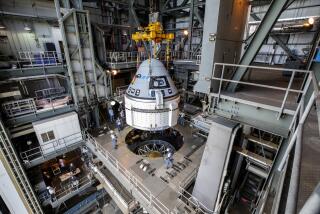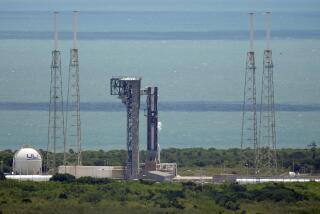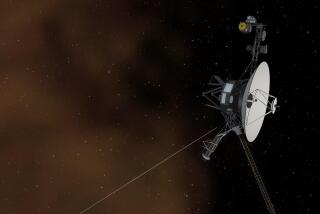Some Experts See Blow to ‘Star Wars’ Credibility : Lack of Computer Warnings Indicated
WASHINGTON — As experts here began to grapple Wednesday with the implications of the space shuttle Challenger’s loss, one of the most troubling issues was the apparent lack of warning from the five computers on board.
Some specialists saw the tragedy as an indication that the Reagan Administration’s “Star Wars” space defense program will not work because, as one critic said, “imperfect people cannot create perfect machines.”
“The computers didn’t warn of any danger yesterday, and computers would be a major part of any (‘Star Wars’) plan to track and destroy hundreds of attacking warheads,” the critic, John Pike of the Federation of American Scientists, said.
Other experts dismissed such a view as premature, pointing out that Challenger’s on-board computers were improved versions of machines that were “state of the art” 15 years ago, when the manufacture of the shuttles began. Significant advances in computer technology have been made since then, and presumably any missile defense system would incorporate them.
Information Stopped
Key National Aeronautics and Space Administration officials have said that there was no evidence of any “significant anomalies” in data from the shuttle Challenger up to the moment it exploded Tuesday, when information being radioed from the spacecraft suddenly stopped.
NASA engineers had been operating on the premise that some key indicator would change and be sensed instantaneously by one of the five computers on board before any catastrophic failure occurred.
“The computers might have automatically reacted to danger signals to avoid an explosion, perhaps switching off an engine,” one expert said. “The shuttle and its crew might or might not have had time to escape, but the warning signs would have been recorded on (magnetic) tape on the ground for us to evaluate.”
He concluded: “As I understand it, there was nothing unusual until the blast.”
Illustrative Examples
As a result, several possibilities exist, this expert speculated, although he emphasized that the examples were illustrative only:
--The type of failure was so thoroughly unpredictable that it was not monitored by computers or was given such a low probability of occurrence that too few sensing gauges or too few readings were made to detect the danger in the final milliseconds of Challenger’s flight.
--The critical sensing gauges themselves failed a split second before the explosion, perhaps because of the same forces that immediately destroyed the vehicle and killed the seven crew members aboard. The shuttle was at or approaching the point of “maximum dynamic pressure” when the combination of its speed and the density of the air put maximum aerodynamic stress on the vehicle and the struts by which it was attached to the fuel tank.
Instruments Removed
The anticipated failure points in the shuttle were far more heavily monitored in the first five tests of the shuttle flights, when the vehicle was being proved out. Such monitoring instruments take up weight and space, however, and many of them were removed when the shuttle began regular operations.
--A far less likely scenario, one expert said, is that Challenger’s computers themselves failed. Four of the computers are exact copies so that if one developed an internal hardware problem, the other three would instantly “out vote” its instructions.
Moreover, the fact that computers in general have improved greatly over the last 15 years is no indictment of the capabilities of Challenger’s computers, this expert emphasized, and offers even less reason to argue that the lack of computer warning of the explosion necessarily means that the “Star Wars” program would fail.
Confidence at Risk
Nonetheless, public confidence in “Star Wars,” formally known as the Strategic Defense Initiative, might be undermined by the tragedy, said William Schneider, a political analyst for The Times and a public opinion scholar.
Support for the U.S. space program across the board probably will not fall, he said, but the disaster will probably cast doubts on the practicality of “Star Wars.”
“The public argument for SDI is entirely technological,” Schneider said. “It rests on the premise that, through technology, we can do anything--even develop an impenetrable shield against nuclear weapons. Polls show that by about 2 to 1, people think a space-based defense system would work.
“I think that Tuesday’s tragedy is bound to raise doubts that may make that margin measurably smaller,” he said. “People have been reminded that, as advanced a society as we may be, mistakes will happen.”
More to Read
Sign up for Essential California
The most important California stories and recommendations in your inbox every morning.
You may occasionally receive promotional content from the Los Angeles Times.










